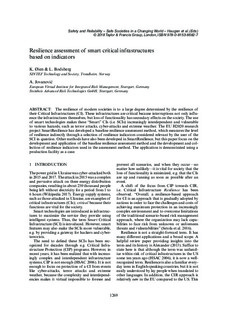| dc.contributor.author | Øien, Knut | |
| dc.contributor.author | Bodsberg, Lars | |
| dc.contributor.author | Jovanovic, A. | |
| dc.date.accessioned | 2019-04-03T07:31:02Z | |
| dc.date.available | 2019-04-03T07:31:02Z | |
| dc.date.issued | 2018 | |
| dc.identifier.citation | Safety and Reliability – Safe Societies in a Changing World. Proceedings of ESREL 2018, June 17-21, 2018, Trondheim, Norway, 2018, 1269-1278 | nb_NO |
| dc.identifier.isbn | 9781351174657 | |
| dc.identifier.uri | http://hdl.handle.net/11250/2593039 | |
| dc.description.abstract | The resilience of modern societies is to a large degree determined by the resilience of their Critical Infrastructures (CI). These infrastructures are critical because interruptions not only influence the infrastructures themselves, but loss of functionality has secondary effects on the society. The use of smart technologies makes these “Smart” CIs (i.e. SCIs) increasingly interdependent and vulnerable to various hazards, such as terror attacks, cyber-attacks and extreme weather. The EU H2020 research project SmartResilience has developed a baseline resilience assessment method, which measures the level of resilience indirectly through a selection of resilience indicators considered relevant by the user of the SCI in question. Other methods have also been developed in SmartResilience, but this paper focus on the development and application of the baseline resilience assessment method and the development and collection of resilience indicators used in the assessment method. The application is demonstrated using a production facility as a case | nb_NO |
| dc.language.iso | eng | nb_NO |
| dc.title | Resilience assessment of smart critical infrastructures based on indicators | nb_NO |
| dc.type | Chapter | nb_NO |
| dc.description.version | publishedVersion | nb_NO |
| dc.source.pagenumber | 1269-1278 | nb_NO |
| dc.identifier.doi | 10.1201/9781351174664-160 | |
| dc.identifier.cristin | 1688475 | |
| dc.relation.project | EC/H2020/700621 | nb_NO |
